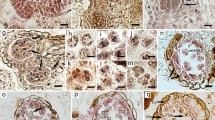Abstract
Despite the potential that apomixis has for agriculture, there is little information regarding the genetic control of its functional components. We carried out a cytohistological investigation on an F1 segregating population of Poa pratensis obtained from a cross between a sexual and an apomictic parent. About half of the F1 progeny plants were parthenogenic, as adjudicated by an auxin test. The degree of parthenogenesis ranged from 1.44% to 92.9%. Apospory was detected in parthenogenetic plants as well as in two non-parthenogenetic individuals. These results indicate that two distinct genetic factors control apospory and parthenogenesis in P. pratensis and that apospory and parthenogenesis may be developmentally uncoupled
Similar content being viewed by others
Author information
Authors and Affiliations
Additional information
Electronic Publication
Rights and permissions
About this article
Cite this article
Albertini, E., Porceddu, A., Ferranti, F. et al. Apospory and parthenogenesis may be uncoupled in Poa pratensis: a cytological investigation. Sex Plant Reprod 14, 213–217 (2001). https://doi.org/10.1007/s00497-001-0116-2
Received:
Accepted:
Published:
Issue Date:
DOI: https://doi.org/10.1007/s00497-001-0116-2




